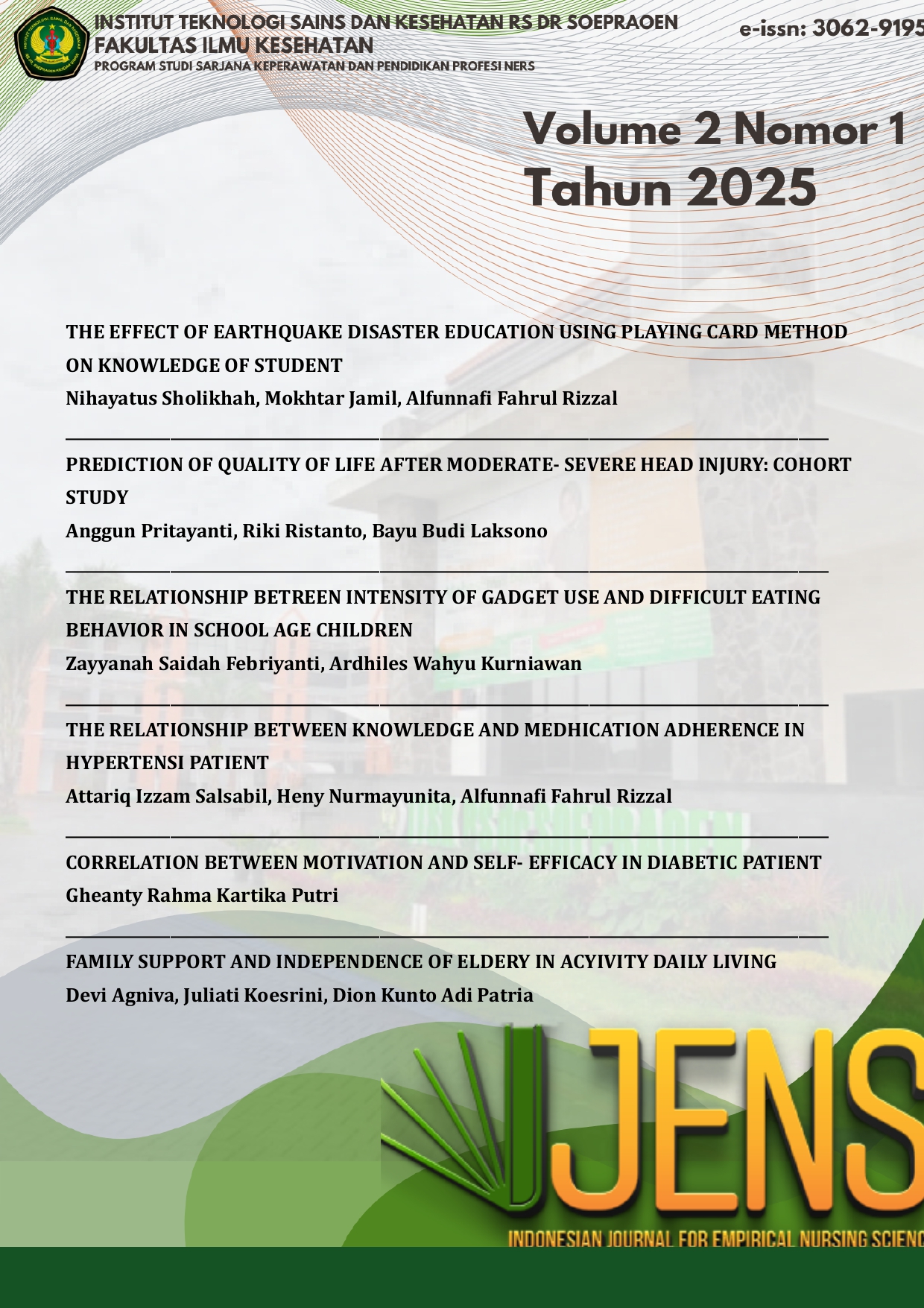THE RELATIONSHIP BETWEEN THE INTENSITY OF GADGET USE AND DIFFICULT EATING BEHAVIOR IN SCHOOL-AGE CHILDREN
DOI:
https://doi.org/10.47794/ijens.v2i1.65Keywords:
intensity of gadget use, difficult eating behaviorAbstract
In this era of over-evolving technology, gadgets have become an integral part of everyday life, including for school-aged children. Therefore, a deeper investigation into the impact of gadget use on children’s eating habits at the local level is crucial to minimizing its impact. This issue is particularly evident at SDN 01 Sumber Sekar Dau, reflecting a broader phenomenon related to gadget use among children. When children spend more time playing with gadgets, such as gaming and watching videos, this reduces the time for physical activity and healthy social interactions. As a result, many children prefer fast food over healthy eating options, leading to fussy eating behavior. This study adopted a quantitative design with a questionnaire method. A total of 75 students were sampled using a total sampling technique. The results of the statistical test showed a p-value of 0,007, indicating a significant relationship between the intensity of gadget use and fussy eating behavior. In addition, the coefficient r of 0,353 indicates a positive relationship with a weak to moderate correlation strength. Thus,it can be concluded that the intensity of gadget use and difficult eating behavior are proven. The higher the intensity of gadget use, the greater the possibility of children experiencing difficult eating behavior.
References
Hariri, Ria, Lutfi Hakim, and Riska F.Lestari. 2020. “Sistem Monitoring Detak Jantung Menggunakan Sensor AD8232.” 02(02):1–5.
Haryanti, Rosalia Tri, Tri Susilowati, and Irma Mustika Sari. 2022. “Hubungan Intensitas Penggunaan Gadget Terhadap Status Gizi Pada Siswa SMK Batik 2 Surakarta.” ASJN (Aisyiyah Surakarta Journal of Nursing) 3(1):27–33. doi:10.30787/asjn.v3i1.897.
Heriyanti, Hera, Lindriani Lindriani, and Irma Apriani. 2022. “Faktor Yang Berhubungan Dengan Perilaku Sulit Makan Pada Anak Usia Prasekolah.” Mega Buana Journal of Nursing 1(1):22–33. doi:10.59183/mbjn.v1i1.4.
Indriani, Dian, Sri Intan Rahayuningsih, and Sufriani. 2021. “Durasi Dan Aktivitas Penggunaan Smartphone Berkelanjutan Pada Remaja.” Jim Fkep 5(1):124–30. http://www.tjyybjb.ac.cn/CN/article/downloadArticleFile.do?attachType=PDF&id=9987.
Khoirunnisa, Fania Nurul, Indanah Indanah, Diah Andriani Kusumastuti, and Noviana Ika. 2020. “Korelasi Variasi Jenis Makanan Dan Lingkungan Dengan Pola Makan Anak Usia Sekolah.” Indonesia Jurnal Kebidanan 4(1):14. doi:10.26751/ijb.v4i1.1000.
Lenggono, K A, Q. Sholihah, M. S. Djati, N. Putranto, T. Tangkas, A. P. Hastuti, D. K. P. Adi, and T. Aminah. 2020. “Quality Audit Analysis of the Implementation of Hand Washing 5 Moments 6 Steps for Doctors and Nurses with the Incidence of Plebitis in the Hospital.” Systematic Reviews in Pharmacy. doi:10.5530/srp.2020.1.34.
Rika Widianita, Dkk. 2023. “HUBUNGAN PERILAKU MAKAN DAN PENGGUNAAN GADGET DENGAN GIZI LEBIH PADA REMAJA DI SMA MARTIA BHAKTI.” AT-TAWASSUTH: Jurnal Ekonomi Islam VIII(I):1–19.
Uce 2018).Uce, Loeziana. 2018. “Pengaruh Asupan Makanan Terhadap Kualitas Pertumbuhan Dan Perkembangan Anak Usia Dini.” Bunayya Jurnal Pendidikan Anak 4(2):79–92.
Yumarni, Vivi. 2022. “Yumami 2022).” Jurnal Literasiologi 8(2):107–19. doi:10.47783/literasiologi.v8i2.369.



